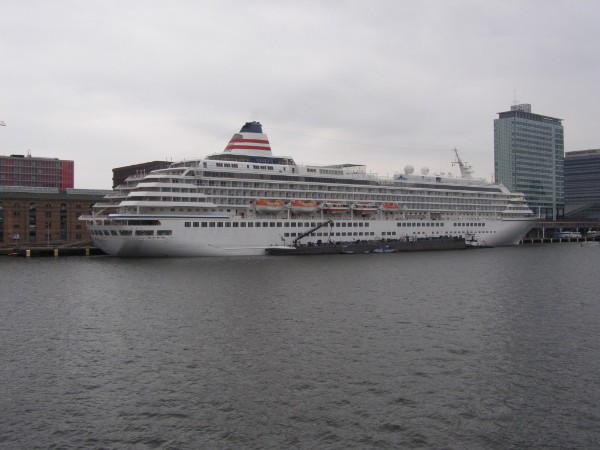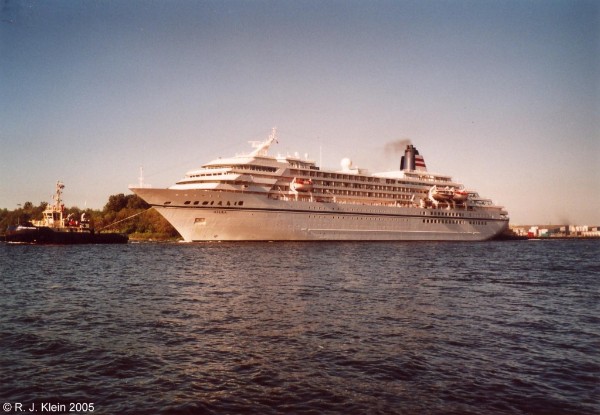Asuka Cruise (NYK Lines)
The NYK Line has a long history in shipping, already when it was officially founded in 1885. The companies official name was Nippon Yusen Kabushiki Kaisha, more-over known as the NYK Line or Japan Mail Shipping Line. It was a combination of two companies (Mitsubishi Mail Steamship Company founded in 1870 as Tsukumo Shokai Shipping and Kyodo Unyu Kaisha founded in 1882) and when they started they owned a fleet of 58 steamships, mainly in the East but from 1899 the company started up a lineservice to London in the UK. Already, the combined company offered a passengerline between Yokohama and Shanghai from 1875 onwards.
In the early 1900's, the company rapidly expanded and became the largest shipping company in the East, connecting Japan to Australia, New Zealand, the westcoast of the USA, Europe, India and almost the whole of the South Pacific. In the 1920's, the company introduced it's first motorships and in 1929 the first motor passengership was introduced.
In december 1941, the Japanese Empire entered the Second Worldwar with the bombing of the American naval port of Pearl Harbour at Hawaii and like all other shippingcompanies in the world, NYK afterwards provided ships for the warefforts of their countries of origin. Their ships were now mostly operated as militairy transports or hospitalships, especially well needed because of the vast distances between the islands of the Pacific. And, when the war ended in 1945, the toll the company had paid was great as they of course were part of the losing side. NYK had lost 185 ships of their fleet and of the 37 passengerships they had owned before the war started, only one survived, the Hikawa Maru. This ship was built in 1930 for services between Japan and Seattle and was sold back by the USA to NYK in 1947. From 1950 onwards, she again started her services across the Pacific and was finally taken out of service in 1961, when she bacame a youth hostel and museumship in Yokohama harbour, where she still remains. In 2006, NYK actually bought the ship back when no other buyer was there to give the ship a future and she thus became the only classic oceanliner in the world that it still owned by the company she was was built for. The ship was restored during 2007 and re-opened in 2008 under her new name of NYK Hikawamaru.
Below, Asuka II is seen docked at Amsterdam at the 22nd of may in 2008.

After the war, NYK operated no ships, as all surviving vessels were confiscated by the victorious allied forces. But several of those had been sold back during the late 1940's and NYK again started to regain some of thei pre-war status. They expanded rapidly and in the 1950's, their ships were again seen world-wide after the company first had concentrated on mostly local trades. From the early 1960's onwards, the company concentrated on cargoservices, as passengerservices were declining sharply due to economic and technological changes in the world. When the company sold the Hikawa Maru, their long history in passenger operations thus ended.
During the 1970's, Mitsui OSK Lines, one of NYK's largest rivals, rebranded their three ship passengerfleet that had been operated under the name of Japan Emigration Ship Company since 1963 as Mitsui OSK Passenger Company, adding the Brasilian liner Rosa de Fonseca in 1975 as Seven Seas, renamed to Nippon Maru in 1977. It's successfull introduction lead to a renewed enthousiasm in Japan for cruising in general and was also a reason for NYK to re-think. Next to Mitsui OSK, there was also a new company started up under the name of Japan Cruise Line, a consortium of several local ferrycompanies. They launched their new 22.000-ton Orient Venus for Pacific cruises. The NYK company did not follow their rivals instantly, but in 1986 they finally reacted by starting to do research for the creation of a totally new brand within their portfolio under the name of Crystal Cruise Line. In 1988, the company was officially founded. At that same time, Mitsui OSK had built a new ship, the 23.000-ton Fuji Maru that first sailed in april 1989. Next to that, they ordered a new ship too, the 22.000 ton Nippon Maru, a modern follow-up to the former vessel with the same name. This ship entered service in september 1990 and concentrated on the local Japanese market with her homeport being Tokio. Crystal Cruises was meant to be a global, luxury line and introduced their first ship Crystal Harmony, homeported at Nassau in july of the same year. She measured almost 50.000 tons and was the largest Japanese-owned passengership in history. Of course, with NYK being part of the Mitsubishi Group, the ship was built in Japan at the Mitsubishi Heavy Industries Yards at Nagasaki. She was the first passengership in the NYK fleet since the sale of Hikawa Maru in 1961, but tasted for more due to her success. In 1995, Crystal Cruises introduced a slightly larger sistership, the Crystal Symphony and to strenghten their name as a global company, the ship was named in New York at the thirth of may 1995.
In between, NYK also restarted cruising under their own name with the Asuka, a 29.000 ton cruiseliner that directly was going to compete with Mitsui's Nippon Maru in the Japanese market. She was introduced in late december 1991, mostly sailing the Pacific and around Australia. So it seemed that the Japanese cruisemarket was again opening up, although the introduction of these ships was not directly followed by new ones. In 1997, Venus Cruise or Japan Cruise Line had built a second ship named Pacific Venus, but this also measured just 26.000 tons and the company hasn't introduced new ships since and she is rarely seen outside East Asia. Next to that, they also reduced to a one-ship operation and took their Orient Venus out of service in 2002 as she was sold to Europe and became known under the names Delphin Voyager, Happy Dolphin and Aegean Paradise.
In the summer of 2005, Asuka visited Western Europe just before her charter to the German firm Phoenix Reisen. It was the first time that a passengership from NYK showed herself in Europe since the ending of the European services before the second worldwar. The ship is here seen sailing past IJmuiden after a visit to Amsterdam.

NYK seems to have the best papers though, as they introduced a new ship for their Crystal Cruises brand in 2003 under the name of Crystal Serenity. She measured almost 70.000 tons, making her with ease the largest Japanese owned ship ever, although she really is sailing the international market. Next to that, her introduction was also followed by a shift in ships, as Crystal Harmony was replaced in the fleet of NYK Cruises as Asuka II, reducing the Crystal fleet to just two ships again from december 2005 onwards. She also was no supplement to the Asuka, as that ship was chartered out to the German company Phoenix Reisen as their Amadea, after a first cruiseseason from the NYK ship in Europe. Also, in 2015 NYK sold their Crystal cruises brand to Genting Hong Kong, the former owners of Norwegian Cruise Line, thus now they are back to a one-ship operation, just as Japan Cruise Line. Mitsui OSK has still two passengerships in operation, making it just a total number of four larger cruiseships dedicated to the Japanese market, all built in the early to mid 1990's.
We cannot say it is the financial strenght that keeps them back, as the NYK Group has a fleet of 832 ships sailing in 2015 and also the company seems to be interested in passengerservices. Maybe with the current growth in China and the Pacific, we will again see some investments made over the next years.
A ship that has been sailing for NYK Cruises before is listed below
Asuka (1991-2005) is placed under Phoenix Reisen as Amadea
For booking information, visit the website of Asuka Cruise, but beware, it is in Japanese. There is a possibility for English translation, though.

